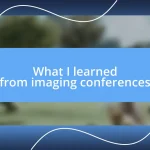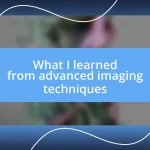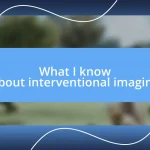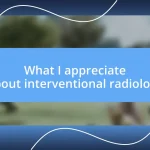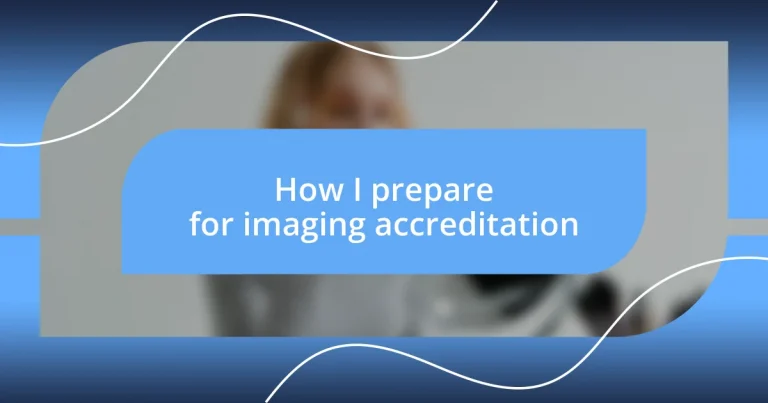Key takeaways:
- Understanding accreditation standards and protocols is crucial for ensuring high-quality medical imaging, fostering both compliance and patient-centered care.
- Creating a structured study schedule, along with gathering resources and practicing with mock exams, significantly enhances preparation and builds confidence for the accreditation exam.
- Final preparations should focus on organization and mental readiness, including setting a study environment that simulates exam conditions and ensuring adequate rest before the test.
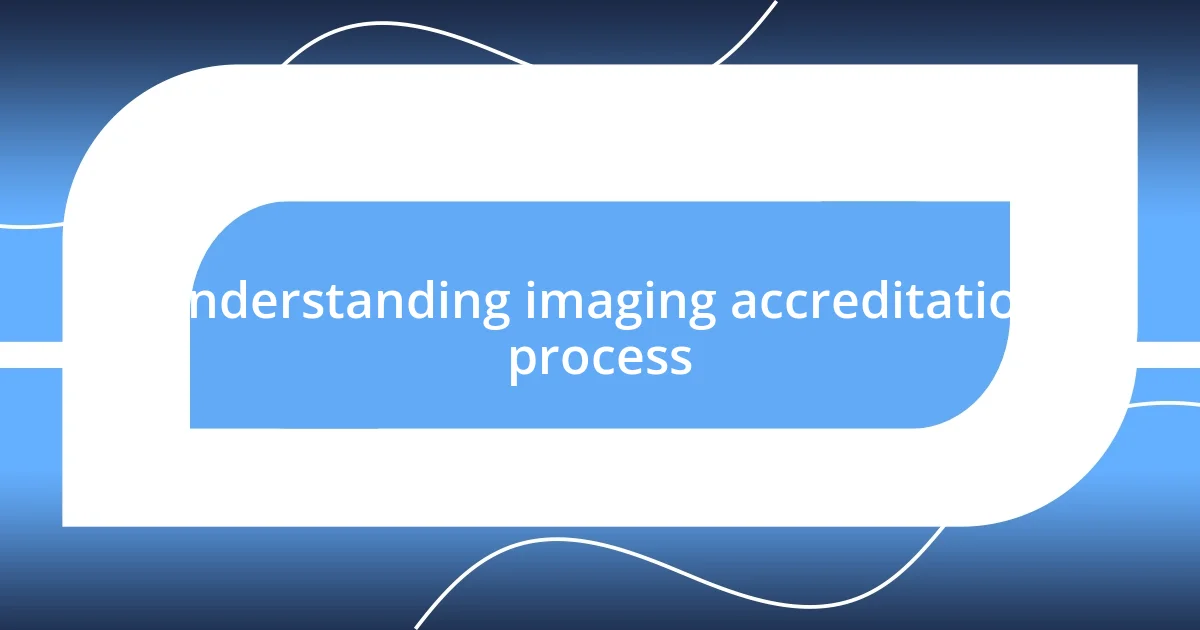
Understanding imaging accreditation process
Understanding the imaging accreditation process is essential for anyone looking to maintain high standards in medical imaging. From my experience, the process can often feel overwhelming, as it involves a thorough evaluation of protocols, safety measures, and equipment performance. Have you ever stood in front of a checklist that seems endless? It’s a familiar feeling, but breaking it down into manageable steps makes it less daunting.
As I navigated my own journey through accreditation, I found that each step taught me something valuable about the importance of consistency and quality control. Regular internal audits helped me identify areas for improvement long before the external reviewers arrived. I remember vividly the sense of accomplishment when passing that review, feeling like I was part of something bigger than myself in the medical community.
Additionally, I realized that clear communication among the team is vital during this process. Establishing an ongoing dialogue about compliance not only keeps everyone informed but also fosters a culture of accountability and excellence. Have you seen how that shared commitment elevates overall performance? It transforms the accreditation process from a task to a team-building opportunity, making the effort worthwhile.
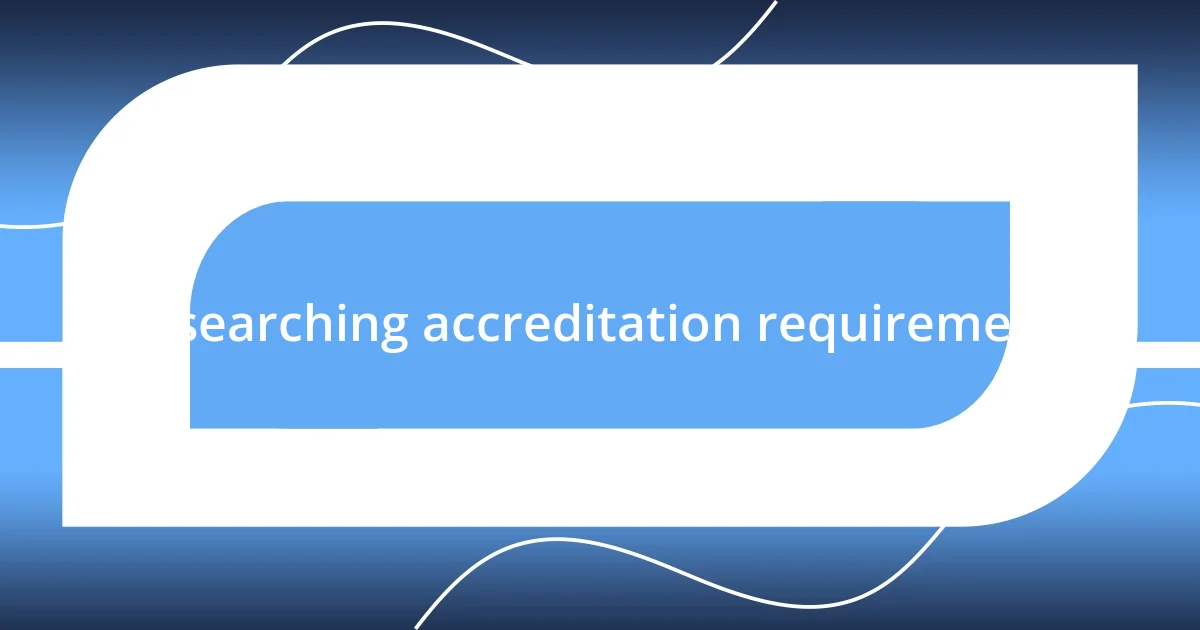
Researching accreditation requirements
Researching accreditation requirements is a critical first step in preparing for the imaging accreditation process. From my own experience, I found that diving deep into the specific standards of the accrediting bodies—like the American College of Radiology or the Joint Commission—made all the difference. It’s not just about skimming through documents; it’s about understanding the “why” behind each requirement. Have you ever felt overwhelmed by jargon? I certainly did, but once I took the time to dissect the language and seek clarification, everything started making sense.
I remember the moment I downloaded the accreditation guidelines and printed them out. I spent several evenings going through each section, highlighting key points, and making notes. It felt tedious at first, but the more I immersed myself, the more I began to see the connections between the requirements and our daily practices. What struck me was how these standards not only aim for safety and quality but also actively promote patient-centered care. When you start to appreciate that perspective, it fuels your motivation to comply and exceed those standards.
In comparing the different accrediting organizations, I learned that while their frameworks are similar, there are nuances that can impact your facility’s approach. For instance, some may emphasize equipment standards more heavily, while others might focus on personnel training. I created a table to help my team visualize these differences, facilitating more thoughtful discussions during our preparatory meetings. This kind of research, paired with open dialogue, fosters not only compliance but inspires a shared commitment to excellence.
| Accrediting Body | Main Focus |
|---|---|
| American College of Radiology | Quality of imaging and patient safety |
| Joint Commission | Overall healthcare organization compliance |
| Radiology Accreditation Commission | Technological advancements and protocols |
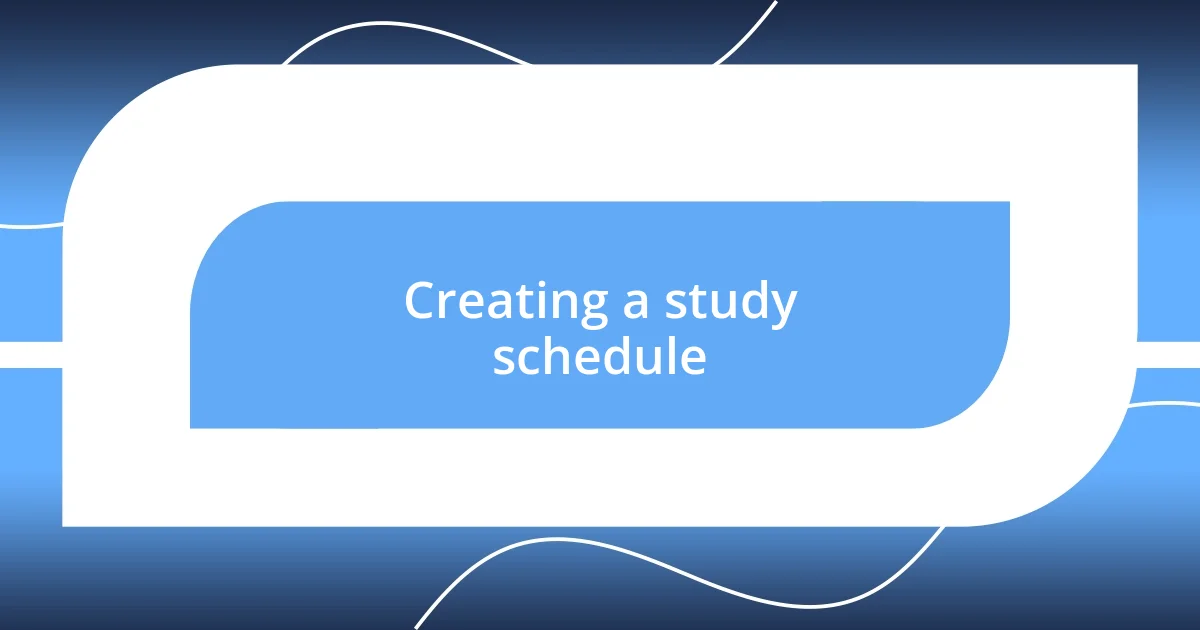
Creating a study schedule
Creating a study schedule is one of the most practical steps when gearing up for imaging accreditation. I recall the first time I dove into this task; I felt a mix of excitement and anxiety. I realized early on that without a structured approach, I could easily lose track of vital information. To craft a meaningful schedule, I set aside dedicated blocks of time each week to focus solely on study materials, ensuring I wasn’t cramming at the last minute. Here are a few tips I found useful:
- Break down the study material into manageable sections.
- Allocate specific times for each topic, using a digital calendar or planner.
- Integrate regular review sessions to reinforce what you’ve learned.
- Incorporate practice tests to assess your knowledge and adjust your study plan.
As I developed my schedule, I found that staying consistent made all the difference. Each study session felt like a step toward mastery rather than an obligation. I began to visualize the progress I was making, which fueled my motivation. It’s fascinating how the act of mapping out study times transformed my approach. I remember feeling a sense of relief as I ticked off completed topics, one by one. Celebrate those small victories; they’re crucial in keeping you engaged and focused as you work towards your accreditation goal.
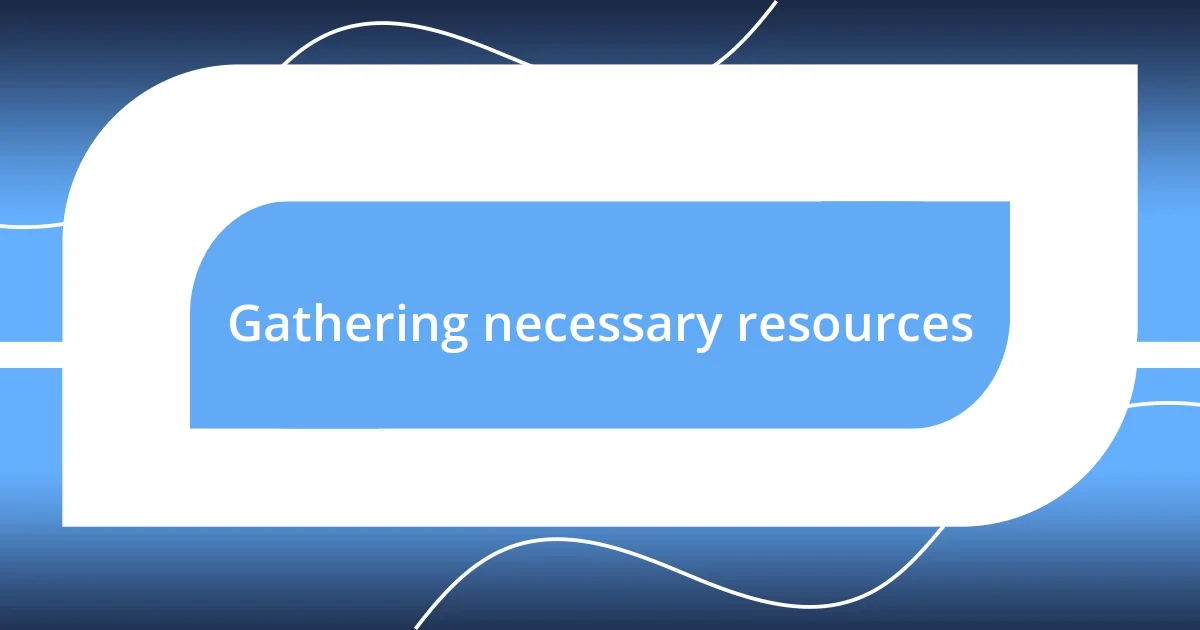
Gathering necessary resources
Gathering necessary resources for imaging accreditation is an essential step that often gets overlooked. I vividly recall the time I began assembling all the materials I might need—guidelines, past inspection reports, and even articles on best practices. It was like putting together a puzzle. I found it both thrilling and daunting when I realized just how much information was out there. Have you ever felt lost trying to find all that data? I certainly have, but I quickly learned that creating a designated folder on my computer and another physical binder for printed materials streamlined the process. It made everything so much easier to access when I needed to reference something on the fly.
One resource I relied heavily on was online forums and communities of professionals who had already been through the accreditation process. Connecting with others who shared their experiences and tips proved invaluable. I remember posting a question about specific equipment calibration standards and getting a wave of replies. Each response contributed to my understanding and often led me to additional resources I hadn’t considered. It’s a reminder that collaboration and learning from others is a powerful tool in your preparatory arsenal.
Lastly, don’t underestimate the importance of internal resources. I reached out to colleagues who had been through the accreditation process and learned so much from their stories. They provided insights on what they wished they had known earlier and even shared templates that had worked for them. I still have some of those documents saved, and they continue to serve as a guide. Incorporating both external and internal resources not only helps clarify the accreditation expectations but also builds a supportive network that can make the journey feel less isolating. Have you thought about who in your circle could provide valuable insights? The answers may surprise you.
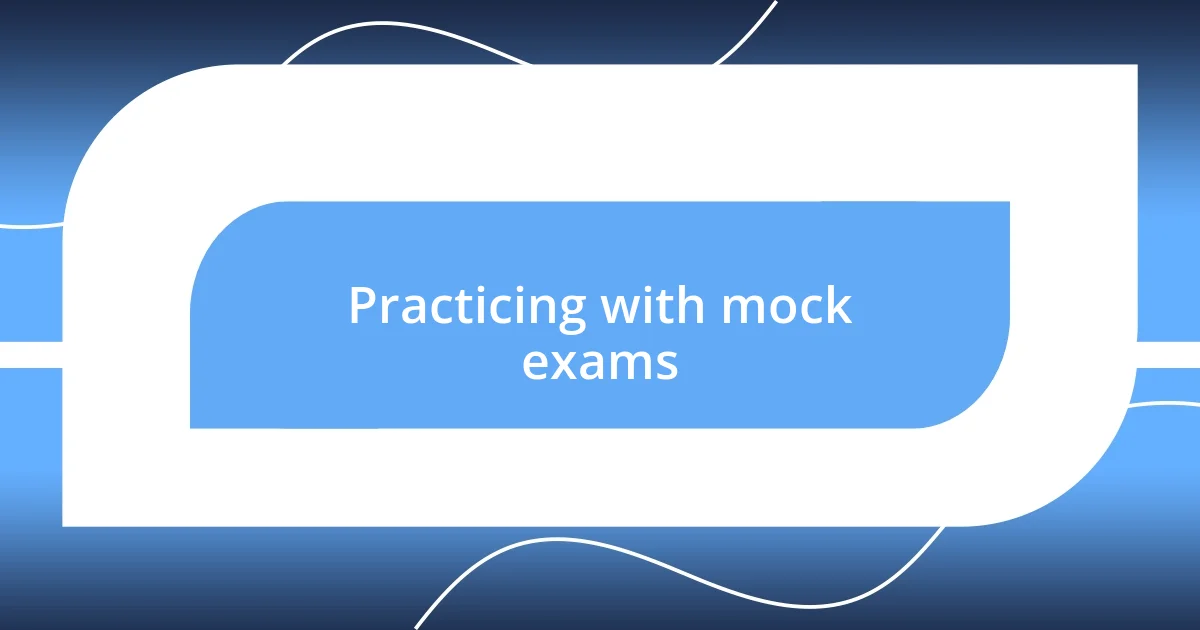
Practicing with mock exams
Practicing with mock exams is a cornerstone of my preparation strategy for imaging accreditation. I remember how nervous I felt when I first encountered full-length practice tests. It was a mix of excitement to see how much I had learned and apprehension about the gaps in my knowledge. What’s fascinating about mock exams is that they mimic the pressure of the actual test environment. I found that taking timed practice tests solidified my understanding and helped me identify the areas I needed to focus on.
I vividly recall one practice exam that truly challenged me. I thought I had grasped the material, only to realize I struggled with certain subject areas. It was humbling but equally enlightening. I used these experiences to not just re-study those topics but also to adjust my study schedule, making it more targeted. Have you ever had a moment where a seemingly small setback turned into an invaluable lesson? For me, these mock exams served as stepping stones, transforming my weaknesses into strengths.
Additionally, I often enlisted a friend to take the mock exams alongside me. This approach not only made learning more enjoyable but also introduced a sense of accountability. We would discuss the answers afterward, which deepened our understanding of the material. I’ve always believed that two heads are better than one, especially when it comes to complex subjects. Sharing insights made those late-night study sessions feel less daunting and more like shared exploration. Mock exams are not merely tests but vital tools to refine your knowledge and enhance your confidence. Are you ready to make them a part of your study routine?
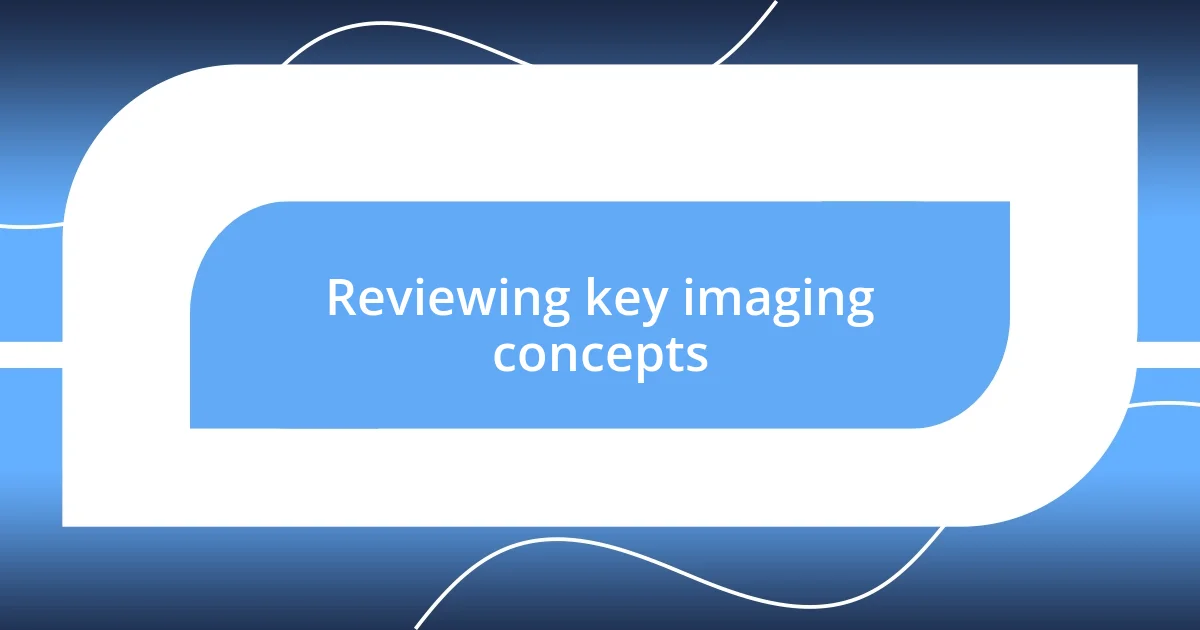
Reviewing key imaging concepts
Reviewing key imaging concepts is an essential part of my preparation process for accreditation. I remember the first time I pulled out my old textbooks and lecture notes. The nostalgia hit me, but so did the anxiety of realizing how much foundational knowledge I had to brush up on. It often felt overwhelming—have you ever tried to juggle multiple topics at once? I found that breaking down complex concepts into bite-sized pieces not only made the material more manageable but also enjoyable to revisit.
One technique that worked wonders for me was creating visual aids. I can still picture the colorful mind maps I crafted, linking major topics to their sub-concepts. This involved a mix of creativity and critical thinking, which kept me engaged. I often asked myself, “What’s the best way to visualize this information?” By actively engaging with the material in this way, I could reinforce what I’d learned and make those connections stick. It transformed sometimes-dry content into something dynamic and relatable.
Furthermore, I didn’t shy away from experimenting with varied resources—like podcasts or video lectures—aimed at the imaging field. One time, while listening to an expert explain the physics behind ultrasound, I had one of those enlightening moments where everything suddenly clicked. Isn’t it amazing how a different perspective can illuminate a topic? Learning is a journey, and the diverse formats helped me grasp key concepts in a more profound way, making sure I was well-equipped for my accreditation journey. What different avenues have you explored during your review sessions?
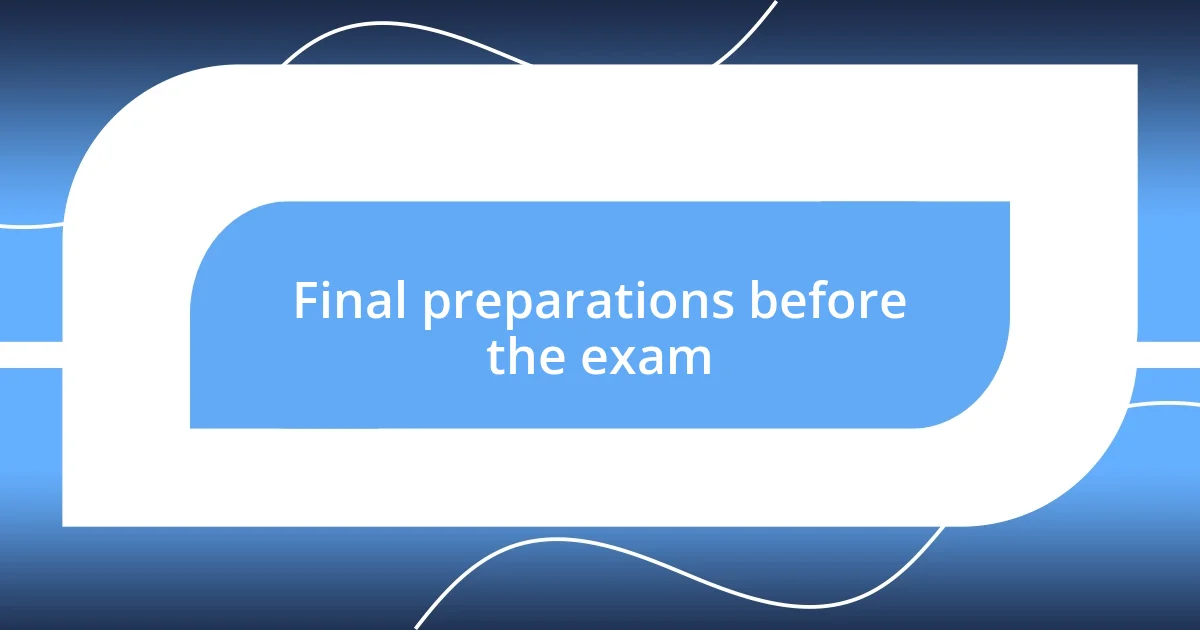
Final preparations before the exam
As I edged closer to the exam date, my final preparations took on an intensified focus. Setting a schedule became crucial; I prioritized my weaker subjects while allowing time for a comprehensive review of everything I had studied. I vividly recall marking days on my calendar with specific goals, which not only kept me organized but also ignited that familiar spark of motivation. Have you ever felt that rush of accomplishment when you check off a task? It’s a simple yet effective way to maintain momentum as the exam approached.
One of my go-to strategies was to set up a study environment that mirrored the exam room. I remember rearranging my study space to eliminate distractions, even going so far as to silence my phone and use noise-canceling headphones. It may sound trivial, but creating that focused atmosphere was transformative. I could really immerse myself in the material, but it also allowed me to practice self-discipline. Did you ever try studying in a specific environment before an important exam? Those small details can make a world of difference.
The day before the exam became a ritual in itself. Instead of cramming, I spent my time doing light reviews and ensuring I got plenty of rest. I recall preparing my exam materials the night before, laying out everything I would need, from my ID to snacks for the day. This small act alleviated so much anxiety; knowing I was physically prepared allowed me mental space to visualize success. Isn’t it fascinating how the mind can shift from panic to confidence with just a little organization? Merging practical steps with mental preparation can be crucial for an exam day turned into a celebration of hard work.



